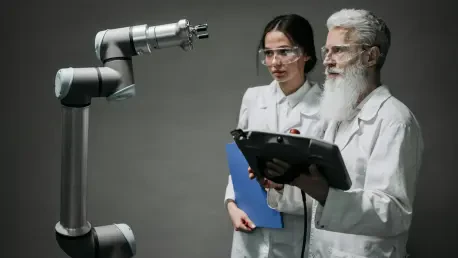Imagine a sprawling warehouse where autonomous mobile robots glide silently, delivering goods, sorting inventory, and handling repetitive tasks with precision, all while being managed from a single cloud-based interface across multiple locations. This is no longer a distant vision but a reality being shaped by cutting-edge collaborations in robotics. The partnership between eInfochips, a leader in product engineering under Arrow Electronics, and InOrbit.AI, a pioneer in AI-powered robot orchestration, is driving a transformative wave in industrial automation. Their edge-to-cloud robotics solutions are addressing the pressing need for scalability and efficiency in industries like warehousing, manufacturing, and logistics, setting a new standard for large-scale deployment of autonomous mobile robots (AMRs).
Key Features of the Collaborative Technology
Edge AI and Hardware Innovation by eInfochips
At the heart of this collaboration lies eInfochips’ expertise in edge technology, harnessed through their dedicated Robotics Center of Excellence. This hub focuses on designing robust hardware, integrating edge AI, and employing sensor fusion to enable AMRs to process data in real time. Such capabilities ensure that robots can react instantly to environmental changes, making them ideal for dynamic industrial settings.
A standout aspect of eInfochips’ contribution is their use of digital twin technology. By creating virtual replicas of physical robots, this approach allows for simulation and testing before deployment, significantly reducing errors and downtime. The seamless integration of these components simplifies the complexity of embedding AMRs into existing workflows, offering businesses a smoother transition to automation.
Cloud Orchestration with InOrbit.AI’s Platform
Complementing the edge capabilities is InOrbit.AI’s Space Intelligence platform, a cloud-based system designed for comprehensive robot management. This tool offers observability, enabling businesses to monitor robot performance across diverse locations from a unified dashboard. Real-time incident management ensures quick resolution of issues, minimizing operational disruptions.
What sets this platform apart is its vendor-agnostic design. Companies can manage fleets of robots from different manufacturers without compatibility concerns, fostering flexibility in scaling operations. Additionally, features like multi-vehicle orchestration and performance optimization allow for fine-tuned control, ensuring that automation aligns with specific business needs.
Performance in Real-World Scenarios
The practical impact of this edge-to-cloud solution becomes evident in industries where efficiency is paramount. In warehouses, for instance, AMRs powered by this technology handle tasks such as goods delivery and inventory sorting, drastically cutting down on manual labor. Large factories benefit from automated cleaning and material handling, streamlining processes that once required significant human intervention.
A notable trend facilitated by this solution is the ability to operate across multiple sites. Businesses can oversee robot fleets in different geographic locations without needing separate management systems, a critical advantage for global operations. This scalability not only boosts productivity but also reduces the time-to-market for implementing automation in new facilities.
Human-robot collaboration is another area where this technology shines. By integrating safety protocols and real-time data processing, the system ensures that robots work alongside human employees without compromising safety. This balance is essential for industries aiming to enhance productivity while maintaining a harmonious workplace environment.
Challenges in Implementation
Despite its promise, deploying edge-to-cloud robotics is not without hurdles. Technical integration remains a significant challenge, as aligning diverse hardware and software systems can be complex, especially in environments with legacy infrastructure. Ensuring that AMRs from various vendors operate cohesively under a single platform often requires substantial customization.
Regulatory and market barriers also pose obstacles. Different regions may have varying standards for robotics deployment, complicating global rollouts. Additionally, the initial cost of adopting such advanced solutions can deter smaller enterprises, limiting widespread adoption in certain sectors.
Efforts to address these issues are underway, with eInfochips and InOrbit.AI focusing on continuous performance monitoring and enhanced interoperability. Tools for incident resolution are being refined to tackle unexpected disruptions, while partnerships with industry stakeholders aim to navigate regulatory landscapes more effectively, paving the way for broader acceptance.
Future Trends and Innovations
Looking ahead, the trajectory of edge-to-cloud robotics appears poised for remarkable growth. Advances in AI are expected to further enhance robot decision-making capabilities, allowing for even more autonomous operations in complex environments. Over the next few years, from 2025 to 2027, the focus will likely shift toward deeper multi-vendor compatibility, enabling businesses to mix and match robotics solutions with ease.
The expansion of cloud orchestration tools is another area to watch. As data processing and storage capacities grow, platforms like InOrbit.AI’s could manage even larger fleets with greater precision, potentially transforming industries beyond traditional manufacturing and logistics. This could open doors to applications in healthcare facilities or retail environments, where automation demands are rising.
A long-term vision for this technology includes redefining human-robot collaboration. As safety and interaction protocols improve, robots could take on more intricate roles alongside human workers, fostering environments where automation augments rather than replaces human effort. This shift holds the potential to reshape operational efficiency across diverse sectors.
Final Thoughts and Next Steps
Reflecting on this technology review, the collaboration between eInfochips and InOrbit.AI proves to be a pivotal step in advancing industrial automation. Their combined edge-to-cloud robotics solution demonstrates impressive capabilities in enhancing scalability and operational efficiency across various sectors. The real-world applications and innovative features underscore a significant leap in managing AMR fleets with precision and flexibility.
Moving forward, businesses looking to adopt this technology should prioritize strategic planning to overcome integration challenges, potentially partnering with experts to tailor solutions to specific needs. Industry leaders must also advocate for standardized regulations to ease global deployments. Investing in training programs for staff to interact effectively with robots emerges as a crucial consideration, ensuring that human-robot collaboration reaches its full potential in transforming workplace dynamics.









